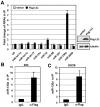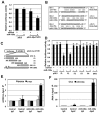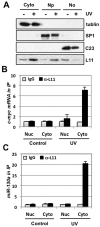MicroRNA-130a associates with ribosomal protein L11 to suppress c-Myc expression in response to UV irradiation
- PMID: 25544755
- PMCID: PMC4359220
- DOI: 10.18632/oncotarget.2728
MicroRNA-130a associates with ribosomal protein L11 to suppress c-Myc expression in response to UV irradiation
Abstract
The oncoprotein c-Myc is essential for cell growth and proliferation while its deregulated overexpression is associated with most human cancers. Thus tightly regulated levels and activity of c-Myc are critical for maintaining normal cell homeostasis. c-Myc is down-regulated in response to several types of stress, including UV-induced DNA damage. Yet, mechanism underlying UV-induced c-Myc reduction is not completely understood. Here we report that L11 promotes miR-130a targeting of c-myc mRNA to repress c-Myc expression in response to UV irradiation. miR-130a targets the 3'-untranslated region (UTR) of c-myc mRNA. Overexpression of miR-130a promotes the Ago2 binding to c-myc mRNA, significantly reduces the levels of both c-Myc protein and mRNA and inhibits cell proliferation. UV treatment markedly promotes the binding of L11 to miR-130a, c-myc mRNA as well as Ago2 in cells. Inhibiting miR-130a significantly suppresses UV-mediated c-Myc reduction. We further show that L11 is relocalized from the nucleolus to the cytoplasm where it associates with c-myc mRNA upon UV treatment. Together, these results reveal a novel mechanism underlying c-Myc down-regulation in response to UV-mediated DNA damage, wherein L11 promotes miR-130a-loaded miRISC to target c-myc mRNA.
Figures







Similar articles
-
Ribosomal protein L11 recruits miR-24/miRISC to repress c-Myc expression in response to ribosomal stress.Mol Cell Biol. 2011 Oct;31(19):4007-21. doi: 10.1128/MCB.05810-11. Epub 2011 Aug 1. Mol Cell Biol. 2011. PMID: 21807902 Free PMC article.
-
Inhibition of c-Myc activity by ribosomal protein L11.EMBO J. 2007 Jul 25;26(14):3332-45. doi: 10.1038/sj.emboj.7601776. Epub 2007 Jun 28. EMBO J. 2007. PMID: 17599065 Free PMC article.
-
Ribosomal protein L11 associates with c-Myc at 5 S rRNA and tRNA genes and regulates their expression.J Biol Chem. 2010 Apr 23;285(17):12587-94. doi: 10.1074/jbc.M109.056259. Epub 2010 Mar 1. J Biol Chem. 2010. PMID: 20194507 Free PMC article.
-
Feedback regulation of c-Myc by ribosomal protein L11.Cell Cycle. 2007 Nov 15;6(22):2735-41. doi: 10.4161/cc.6.22.4895. Epub 2007 Aug 14. Cell Cycle. 2007. PMID: 18032916 Free PMC article. Review.
-
Crosstalk between c-Myc and ribosome in ribosomal biogenesis and cancer.J Cell Biochem. 2008 Oct 15;105(3):670-7. doi: 10.1002/jcb.21895. J Cell Biochem. 2008. PMID: 18773413 Free PMC article. Review.
Cited by
-
The crosstalk between non-coding RNAs and cell-cycle events: A new frontier in cancer therapy.Mol Ther Oncol. 2024 Feb 29;32(2):200785. doi: 10.1016/j.omton.2024.200785. eCollection 2024 Jun 20. Mol Ther Oncol. 2024. PMID: 38595981 Free PMC article. Review.
-
MicroRNA-449a enhances radiosensitivity by downregulation of c-Myc in prostate cancer cells.Sci Rep. 2016 Jun 2;6:27346. doi: 10.1038/srep27346. Sci Rep. 2016. PMID: 27250340 Free PMC article.
-
Micromanaging aerobic respiration and glycolysis in cancer cells.Mol Metab. 2019 May;23:98-126. doi: 10.1016/j.molmet.2019.01.014. Epub 2019 Feb 6. Mol Metab. 2019. PMID: 30837197 Free PMC article. Review.
-
Genome-wide association study with additional genetic and post-transcriptional analyses reveals novel regulators of plasma factor XI levels.Hum Mol Genet. 2017 Feb 1;26(3):637-649. doi: 10.1093/hmg/ddw401. Hum Mol Genet. 2017. PMID: 28053049 Free PMC article.
-
MicroRNA-based screens for synthetic lethal interactions with c-Myc.RNA Dis. 2016;3(3):e1330. doi: 10.14800/rd.1330. Epub 2016 May 30. RNA Dis. 2016. PMID: 27975083 Free PMC article.
References
-
- Luscher B, Vervoorts J. Regulation of gene transcription by the oncoprotein MYC. Gene. 2012;494:145–160. - PubMed
-
- Meyer N, Penn LZ. Reflecting on 25 years with MYC. Nature reviews. Cancer. 2008;8:976–990. - PubMed
-
- Nesbit CE, Tersak JM, Prochownik EV. MYC oncogenes and human neoplastic disease. Oncog ene. 1999;18:3004–3016. - PubMed
-
- Liu J, Levens D. Making myc. Current topics in microbiology and immunology. 2006;302:1–32. - PubMed
Publication types
MeSH terms
Substances
Grants and funding
LinkOut - more resources
Full Text Sources
Other Literature Sources

